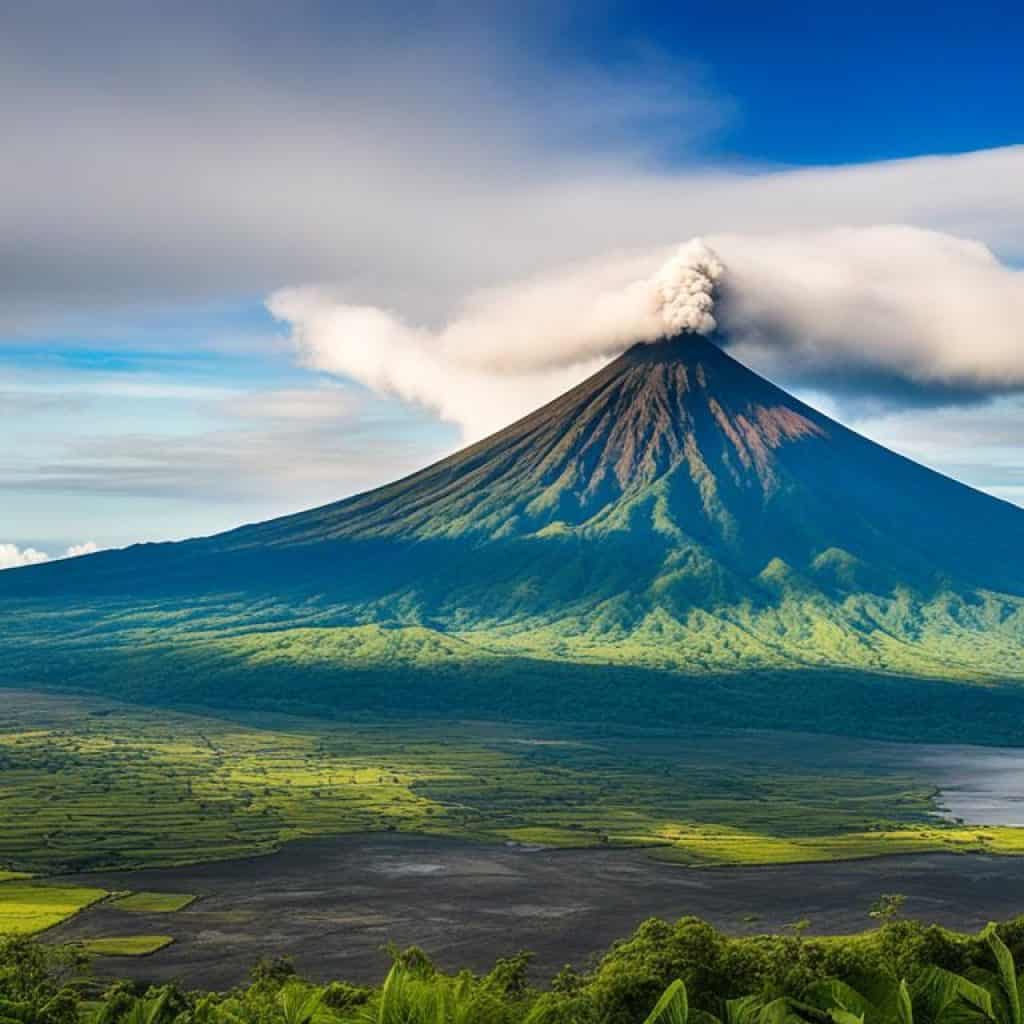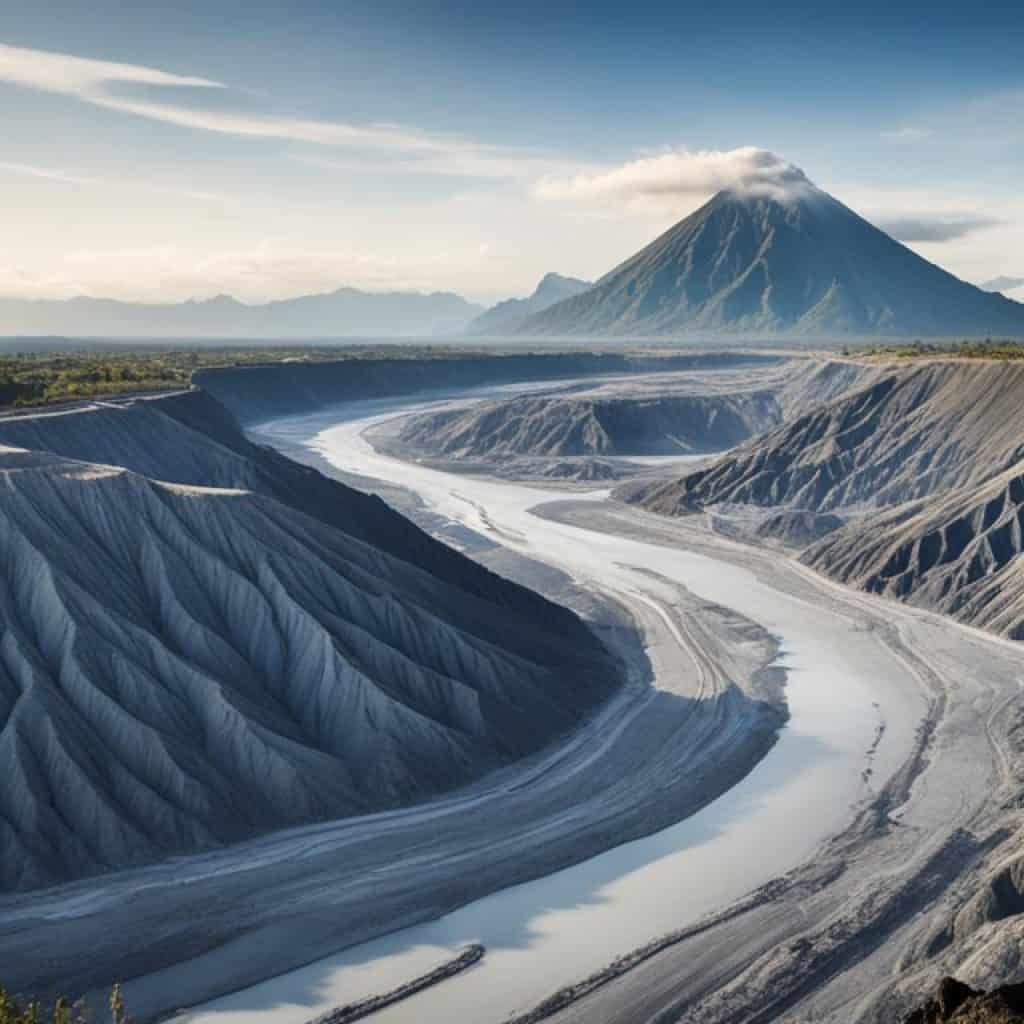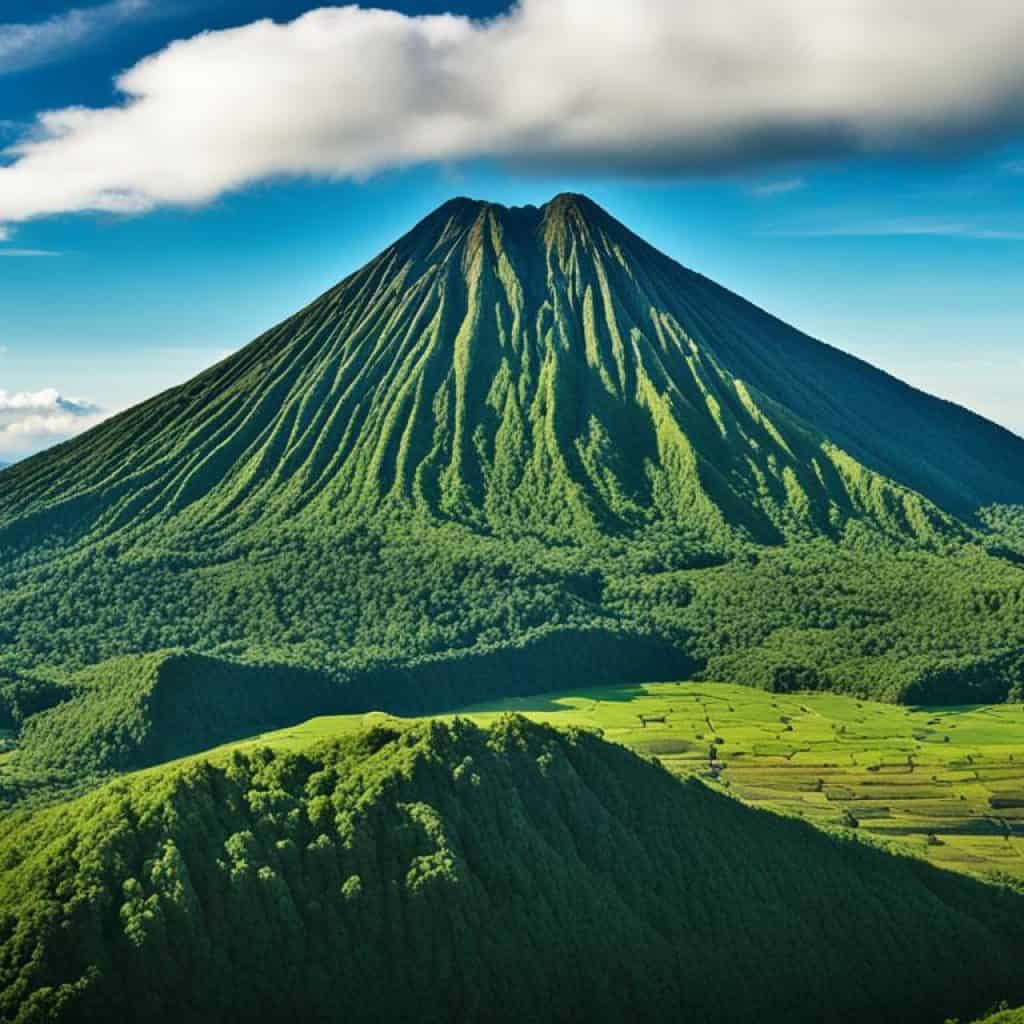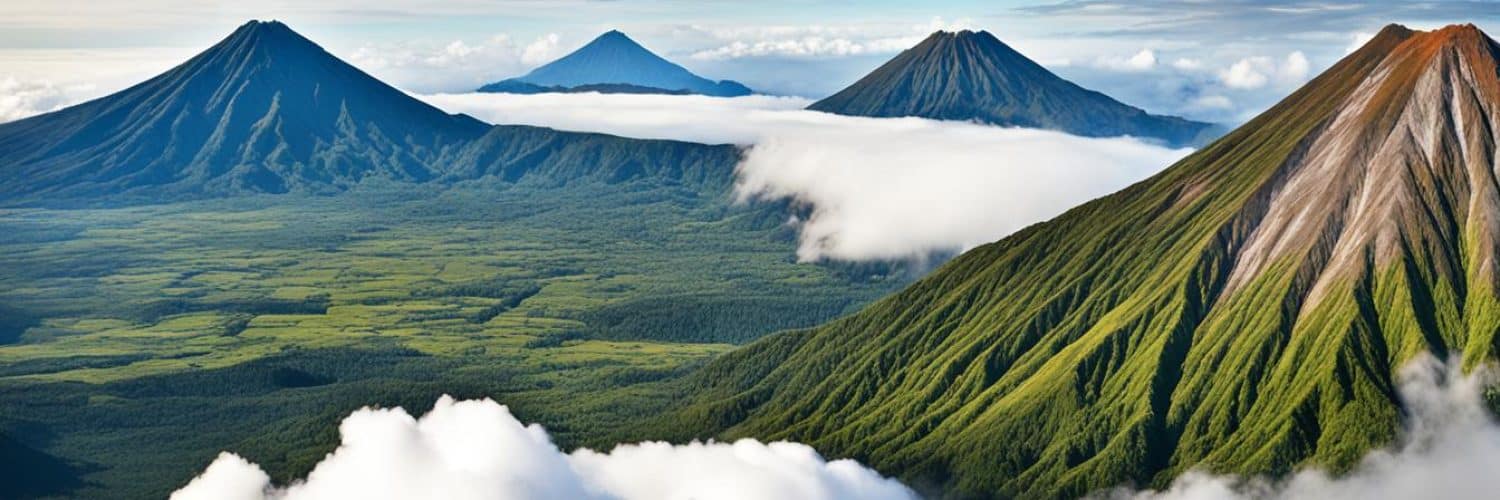Did you know that the Philippines is home to some of the most breathtaking volcanic landscapes in the world? From towering peaks to majestic craters, the volcanic activity in this Southeast Asian country is truly awe-inspiring. In particular, the Philippines boasts an iconic example of a shield volcano that has captivated locals and tourists alike. Can you guess which volcano holds this title and why it stands out among the rest?
Today, we will delve into the fascinating world of shield volcanoes in the Philippines, exploring their unique features, the volcanic activity that shaped them, and how they contribute to the country’s geological heritage. Join us as we uncover the secrets of these magnificent natural formations and discover the wonders of the Pacific Ring of Fire.
Key Takeaways:
- The Philippines is home to numerous shield volcanoes with stunning landscapes.
- Mount Mayon is an iconic example of a shield volcano in the Philippines.
- The volcanic activity in the country is a result of its location in the Pacific Ring of Fire.
- Shield volcanoes play a crucial role in the country’s geological features.
- Exploring these volcanoes provides a deeper appreciation for the Philippines’ natural heritage.
Volcanoes in the Philippines
The Philippines is known for its rich volcanic activity, boasting approximately 300 volcanoes throughout the country. This volcanic landscape is a direct result of the Philippines’ location along the Pacific Ring of Fire, a region renowned for its tectonic activity. Among these volcanoes, 24 are classified as active, contributing to the dynamic nature of the country’s geological features.
Active volcanoes in the Philippines are characterized by their ongoing volcanic eruptions or recent volcanic activities, signifying their potential for future eruptions. These volcanoes serve as powerful reminders of the dynamic nature of the Earth’s crust and the constant reshaping of the earth’s surface.
However, the Philippine archipelago is not only home to active volcanoes. It also encompasses numerous dormant and inactive volcanoes that contribute to its diverse and unique geological landscape. These volcanoes, once active but now devoid of eruptive activities in recent history, offer stunning vistas of their dormant craters and surrounding landscapes. They stand as silent witnesses to the country’s volcanic past and showcase the fascinating geological processes that have shaped the Philippine islands.
Volcanoes in the Philippines – Overview
Here is an overview of the volcanoes in the Philippines:
| Type of Volcano | Number of Volcanoes |
|---|---|
| Active | 24 |
| Dormant | TBD |
| Inactive | TBD |
| Total | 300 |
Note: The number of dormant and inactive volcanoes is yet to be determined.
As the Philippines continues to draw visitors from around the world, the country’s volcanoes play a significant role in attracting nature enthusiasts, adventure seekers, and geology enthusiasts alike. These natural wonders provide a captivating glimpse into the earth’s volatile yet awe-inspiring forces, creating a unique destination for those fascinated by the intricacies of our planet’s geological processes.
Volcanoes in Luzon
Luzon, the largest and most prominent island in the Philippines, boasts several notable volcanoes that showcase the country’s diverse volcanic landscape. Here are some of the prominent volcanoes in Luzon:
Mayon Volcano

Mayon Volcano, located in Albay, is renowned for its perfect cone shape, making it one of the most famous volcanoes in the country. This active stratovolcano is considered sacred in Philippine mythology and is a popular tourist destination. The volcano and its surrounding landscape have been declared a national park and a UNESCO Biosphere Reserve.
Mt. Pinatubo
Mt. Pinatubo, situated in Zambales, gained worldwide attention with its colossal eruption in 1991, one of the largest volcanic eruptions of the 20th century. Despite its devastating history, Mt. Pinatubo has turned into a popular hiking destination, offering guided tours to its crater where the mesmerizing Pinatubo Lake can be observed. The volcano’s eruption left behind a stunning landscape of ash and lava flows, creating a unique sight for visitors to explore.
Taal Volcano
Taal Volcano, located in Batangas, showcases a complex volcano system that includes the captivating Volcano Island. This active volcano has a unique attraction, offering panoramic views of its crater lake. While trekking activities to the summit are currently restricted due to recent eruptions, visitors can still admire the volcanic landscape from towns and vantage points nearby, like Tagaytay. Taal Volcano remains a remarkable and intriguing natural phenomenon in Luzon.
Other Volcanoes in Luzon
Aside from Mayon Volcano, Mt. Pinatubo, and Taal Volcano, Luzon is also home to other notable volcanic peaks. Mt. Arayat in Pampanga, with its mystical origins and panoramic views of Central Luzon, offers a unique experience for visitors. Mt. Makiling, situated in the border of Laguna and Batangas, is a dormant volcano surrounded by lush rainforests, botanical gardens, and natural attractions.
| Volcano Name | Location | Type | Height | Status |
|---|---|---|---|---|
| Mayon Volcano | Albay | Stratovolcano | 2,463 meters | Active |
| Mt. Pinatubo | Zambales | Stratovolcano | 1,486 meters | Dormant |
| Taal Volcano | Batangas | Complex Volcano | 311 meters | Active |
| Mt. Arayat | Pampanga | Stratovolcano | 1,026 meters | Dormant |
| Mt. Makiling | Laguna & Batangas | Stratovolcano | 1,090 meters | Dormant |
These volcanoes in Luzon provide stunning landscapes, recreational activities, and opportunities for visitors to appreciate the geological wonders of the Philippines.
Volcanoes in the Visayas
The Visayas region of the Philippines is known for its diverse volcanic landscape. The region is home to several active and inactive volcanoes, offering unique opportunities for exploration and outdoor activities. Two notable volcanoes in the Visayas are Mt. Kanlaon and Mount Talinis.
Mt. Kanlaon
Mt. Kanlaon, the highest mountain in the Visayas region, is located on Negros Island. It is an active stratovolcano and an example of a shield volcano. With a height of approximately 2,435 meters, Mt. Kanlaon attracts adventurers and nature enthusiasts who are looking to witness the stunning beauty of this volcanic peak. Surrounding the volcano is the Mount Kanlaon Natural Park, a protected area that showcases the region’s rich biodiversity.
Mount Talinis
Mount Talinis, also known as Cuernos de Negros (Horns of Negros), is the second-highest mountain on Negros Island. It is a potentially active volcano, offering thrilling hiking trails and breathtaking views of the surrounding landscape. Mount Talinis is characterized by its twin peaks, rugged terrain, and lush forests. It is a popular destination for outdoor activities such as camping, trekking, and bird-watching.
These volcanoes in the Visayas region provide a unique opportunity to explore the geological wonders of the Philippines. Whether you’re an experienced hiker or a nature lover, the Visayas volcanoes offer stunning landscapes, rich biodiversity, and unforgettable adventures.
Volcanoes in Mindanao
Mindanao, the southernmost major island in the Philippines, is home to a remarkable collection of volcanoes that showcase the diverse volcanic landscape of the country. These majestic peaks not only offer breathtaking views but also hold cultural and ecological significance.
Mount Apo
One of the most prominent volcanoes in Mindanao is Mount Apo, located in the province of Davao. Rising to a height of approximately 9,692 feet, Mount Apo is not only the highest mountain in the Philippines but also a sacred site for indigenous communities. Its majestic presence and surrounding lush forests make it a must-visit destination for adventurous hikers and nature enthusiasts.
Mount Matutum
Situated in South Cotabato, Mount Matutum is another notable volcanic peak in Mindanao. Standing at around 7,640 feet, this dormant volcano offers a picturesque landscape for outdoor activities such as hiking and birdwatching. With its rich biodiversity and stunning natural beauty, Mount Matutum is a hidden gem waiting to be explored.
Mount Hibok-Hibok
Located in the picturesque island of Camiguin, Mount Hibok-Hibok is an active stratovolcano that adds to the allure of Mindanao. Despite its volcanic activity, the surrounding area offers stunning natural attractions, including hot springs, waterfalls, and lush forests. Hiking to the summit of Mount Hibok-Hibok provides visitors with panoramic views of the island and a sense of adventure.
Exploring the volcanoes in Mindanao allows visitors to witness the beauty and power of these natural formations while appreciating the rich geological heritage of the Philippines. From the sacred Mount Apo to the captivating Mount Matutum and Mount Hibok-Hibok, Mindanao’s volcanoes provide immersive experiences that blend adventure, culture, and nature.
Embrace the allure of Mindanao’s volcanic landscape and embark on a journey that promises both thrill and wonder. The stunning vistas and cultural significance of Mount Apo, Mount Matutum, and Mount Hibok-Hibok make them must-visit destinations for nature enthusiasts and adventure-seekers alike.
Mayon Volcano (Albay)
Mayon Volcano, also known as Mount Mayon, is one of the most famous and active volcanoes in the Philippines. It is located in Albay, a province in the Bicol region of the country. With a height of around 2,463 meters, Mayon Volcano is renowned for its symmetrical conical shape, earning it the nickname “perfect cone.”
The volcano has erupted around 50 times in the past decades, making it a significant site for volcanic activity in the Philippines. Despite its activity, Mayon Volcano has become a popular destination for tourists who are drawn to its natural beauty and awe-inspiring presence. Visitors can engage in various activities such as thrilling ATV rides or embark on challenging hikes to lava walls for breathtaking views of the volcano.
Mayon Volcano is not just a geological marvel; it holds cultural and historical significance for the people of the Philippines. It is considered sacred in Philippine mythology and has been a subject of various artistic and literary works. The volcano and its surrounding landscape have been declared a national park and a UNESCO Biosphere Reserve, ensuring its preservation and protection for future generations.
When visiting Albay, experiencing the majestic beauty of Mayon Volcano is a must for adventurers and nature enthusiasts alike. Witnessing this remarkable active volcano in the Philippines up close is an unforgettable experience that captures the power and magnificence of the natural world.
Mayon Volcano Facts
| Height | Location | Number of Eruptions | Features |
|---|---|---|---|
| 2,463 meters | Albay, Bicol Region | Approximately 50 | Symmetrical conical shape |
Mt. Pinatubo (Zambales)
Located within the provinces of Zambales, Tarlac, and Pampanga in Central Luzon, Mt. Pinatubo is a remarkable active volcano in the Philippines. It gained global attention with its cataclysmic eruption in 1991, which stands as one of the largest volcanic eruptions of the 20th century.
Despite its active status, Mt. Pinatubo has become a popular hiking destination, attracting visitors with its breathtaking beauty and unique geological features. Guided tours are available, offering a chance to explore the volcano’s crater and admire the mesmerizing Pinatubo Lake.

The aftermath of Mt. Pinatubo’s eruption has left behind a stunning landscape of ash and lava flows, creating a dramatic vista that showcases nature’s power. This picturesque scenery adds to the allure of the volcano, making it an unforgettable experience for adventurers and nature lovers.
Taal Volcano (Batangas)
Taal Volcano, located in Batangas province, is known for its complex volcano system. The main volcano stands at around 1,020 feet and is surrounded by 47 craters and 4 maars. Taal used to be a popular trekking destination due to its easy trail and proximity to Manila, but trekking activities are no longer allowed due to recent eruptions.
However, visitors can still admire Taal from afar, and it remains one of the most active and intriguing volcanoes in the Philippines. The surrounding towns and Tagaytay offer ideal vantage points to appreciate the majestic views of Taal and its volcanic landscape.
Explore the natural beauty of the Taal Volcano and witness the power of this fascinating complex volcano system. Although trekking is no longer permitted, you can still marvel at its magnificence from nearby towns and enjoy breathtaking views from Tagaytay. Experience the allure of Taal and immerse yourself in the geological wonders of Batangas.
Mt. Arayat (Pampanga)
Discover the mystique of Mt. Arayat, a dormant volcano nestled in the province of Pampanga in Central Luzon, Philippines. Standing at approximately 3,366 feet, Mt. Arayat offers a unique and enchanting experience for adventurers and nature enthusiasts alike.
In local folklore, Mt. Arayat is believed to be home to diwatas, mythical fairies that add an air of mysticism to its surroundings. Immerse yourself in the rich cultural heritage as you explore the geological wonders of this volcanic landscape.
To fully appreciate the beauty of Mt. Arayat, visitors can embark on various hiking trails and access points, such as the Mount Arayat National Park in San Juan Baño town. From here, you can marvel at panoramic views of Central Luzon and the meandering Pampanga River, immersing yourself in the breathtaking vistas the Philippines has to offer.
Whether you seek a spiritual retreat or an adventurous escapade, Mt. Arayat is a captivating destination that combines natural wonders with cultural significance. Prepare to be spellbound as you traverse the trails and uncover the secrets of this dormant volcano.

Mountains of Pampanga
| Mountain | Location | Elevation (feet) |
|---|---|---|
| Mt. Arayat | Pampanga | 3,366 |
| Mt. Pinatubo | Pampanga | 4,879 |
| Mt. Balakibok | Pampanga | 1,981 |
Mt. Makiling (Laguna & Batangas)
Located within the territories of Laguna and Batangas provinces in the Calabarzon region, Mt. Makiling is a dormant volcano that offers a unique and captivating experience for visitors. With an elevation of 3,580 feet, this majestic mountain is part of the Laguna Volcanic Field, showcasing the geological wonders of the Philippines.
Unlike other volcanoes in the country, Mt. Makiling has no recorded historical eruptions, making it a safe destination for exploration and adventure. However, its dormant nature doesn’t diminish its allure. In fact, it offers a range of natural attractions that highlight the beauty and diversity of the region.
Hiking Trails and Nature Exploration
For outdoor enthusiasts, Mt. Makiling provides an extensive network of hiking trails that cater to various skill levels. These trails wind through lush rainforests, allowing visitors to immerse themselves in the enchanting beauty of nature. The rich biodiversity of the mountain is home to numerous plant and animal species, making it a paradise for nature lovers and wildlife enthusiasts.
- Explore the pristine rainforest park, where you can discover rare flora and fauna species that are unique to the area.
- Marvel at the refreshing streams, sparkling waterfalls, and serene pools that offer a respite from the hike.
- Admire the towering trees, ancient rock formations, and breathtaking vistas that surround the mountain.
- Embark on a guided nature walk to learn about the ecological significance of Mt. Makiling and the conservation efforts that protect its natural treasures.
Geothermal Springs and Mud Springs
One of the fascinating features of Mt. Makiling is its geothermal activities, which manifest in the form of hot springs and mud springs. These natural wonders provide a unique therapeutic experience and a chance to unwind amidst the stunning volcanic landscape.
- Indulge in a rejuvenating soak in the geothermal hot springs, believed to have healing properties that promote relaxation and well-being.
- Experience the purifying properties of the mud springs, known for their detoxifying and exfoliating effects on the skin.
- Immerse yourself in the natural beauty of the surroundings while enjoying the warmth and tranquility of the geothermal springs.
Cultural Significance and Mythical Legend
“Mt. Makiling has captivated the hearts of many, not only for its natural beauty but also for its cultural significance. It is believed to be the dwelling place of Maria Makiling, a famed deity in Philippine folklore.”
The mountain is regarded as sacred and is steeped in mythical legends and stories passed down through generations. Maria Makiling, known as the “guardian fairy of the mountain,” is said to protect and bless those who show respect and reverence towards her realm.
Visiting Mt. Makiling allows you to delve into the rich cultural heritage of the Philippines and appreciate the deep connection between nature and mythology.
Conclusion
The Philippines is a treasure trove of volcanic activity and geological features. With iconic examples like the famous Mayon Volcano, active and dormant peaks such as Mt. Arayat and Mt. Makiling, and a myriad of other volcanic landscapes, visitors have plenty to explore. Whether you prefer the physical challenge of hiking to the summit, the awe-inspiring views from a distance, or engaging in activities near these majestic volcanoes, each experience offers a unique blend of beauty and power.
Mayon Volcano, known as a shield volcano, stands as a testament to the Philippines’ volcanic heritage. Its symmetrical conical shape is an iconic sight and symbolizes the country’s geological wonders. Taking the time to explore these volcanoes not only grants access to phenomenal vistas but also fosters a deeper understanding and appreciation of the country’s geology and its place within the Pacific Ring of Fire.
Volcanic activity shapes the landscape of the Philippines, creating breathtaking features that attract visitors from all over the world. The country’s commitment to preserving these natural wonders, with sites like Mount Mayon being designated as a national park and a UNESCO Biosphere Reserve, highlights their cultural and ecological significance. Whether you’re a nature enthusiast, an adventurer seeking thrills, or simply someone marveling at the forces of nature, the Philippines volcanoes offer an unforgettable journey into the heart of geological enchantment.


















Add comment